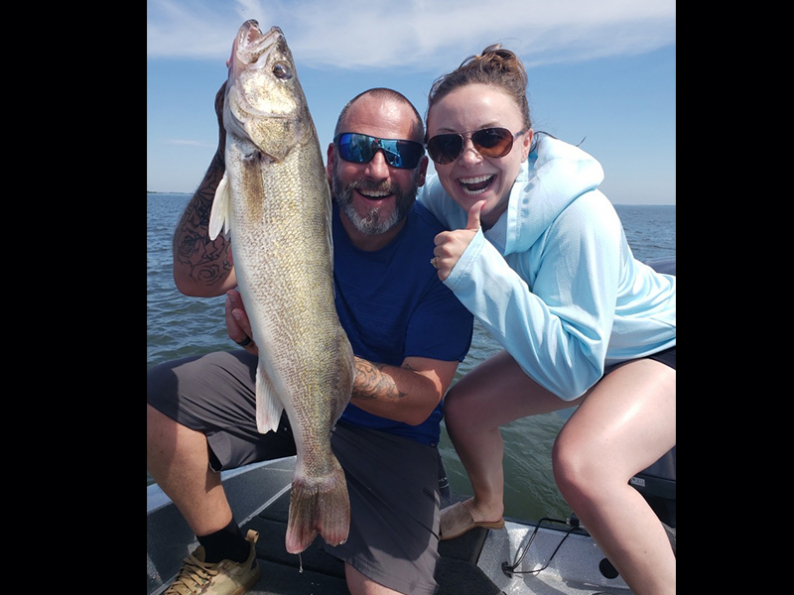
Devils Lake, ND: “Social Distancing” to Devils Lake fishing guides is up close and personal while lifting a walleye in the net. It’s arranging clients so they can easily watch their slip-bobbers. And, high-fiving when they catch any of the lake’s popular summer-time species: walleyes, northern pike and white bass.
Life is returning to normal, with business about “even” right now compared to a year ago, according to Suzie Kenner, Devils Lake Tourism executive director. “Travelers need to take the time to book motels and resorts that coincide with their fishing schedules. The guides still have availability due to earlier Coronavirus cancellations” she said.
The fish are doing well. Biologist Todd Caspers said, “White bass are at record high numbers,” he said. Pike are still above average, and the biologist noted they are not “hammer-handles.” The typical pike observed in test net sampling run mid-20 inches to 34 inches long. “There are always trophies present,” he said.
Walleyes are the main attraction for most anglers. They have reason to smile. "Devils Lake has had decent year classes each spring from 2016 to 2019,” he said. Four year old walleyes average 14 to 15 inches long, and go by the name of “eaters.” He added, “There are still bigger fish out there.”
Two local guides, Johnnie Candle (701-371-9431) and Ancil Reynolds (701-230-0367) shared their mid-summer tactics, along with a couple secrets. Candle is a fishing educator and world walleye champion. Reynolds has the only guide service in North America called, “Ancil’s Guide Service.” Both spend all four seasons on the lake.
Candle’s mid-summer techniques lean to bottom-bouncers and spinners because of their versatility. “Pull them over large rocky structures, mud-flats or along weed edges. I use a silver or gold size three Indiana blades and a 2.5 inch Gulp Minnow. No need for live bait. Catch fish from 8 to 30 feet deep,” he said.
His Lund holds a supply of slip-bobber rods for isolated structure and for fishing precise spots. Plain hooks or tiny jigs with leeches tempt many walleyes for clients. He trolls crank baits on either Fire line or lead core, targeting flooded roads or when locating schools of roaming walleyes in the basin. Cranks include number 5 and 7 Flicker Shads and Rapala Shad Raps and number 5 Salmo Hornets. “Perch and white are great colors,” he hinted.
“The average walleye right now is about 17 inches with a ton of great eating size fish in the system,” he said. They seem to go deeper this time of year, but a good walleye chop puts them into a feeding frenzy, often in “skinny water.”
Candle commented about another species, “White bass have been off the charts this year. Lots of large fish; many days the average is 16 inches. They fight hard and are fun to catch.”
Guide Ancil Reynolds follows a plan – his plan – each day. Walleyes with a unique presentation and pike keep him busy. Now with more pike fly fishermen in his boat, his opinion of these toothy eating-machines has changed. “I used to think pike ate anything that moved. The fly guys taught me that pike are curious and selective. They don’t eat everything. Some followed flies 30 feet without hitting,” he said. The fly fishing sport increases each season, with most “nice” pike in the 32 to 34 inch class. An 18-pounder came to net, but most over 30 inches are released.
Pike are a bonus fish which Reynolds converts into boneless fillets. “People love the flavor and the firmness. After catching and eating pike, they want to target them the next day,” he said.
Walleyes remain the chief attraction for most clients, and each day typically starts shallow. His clients toss small Reef Runners, Salmo Hornets, Flicker Shads, a large assortment of Rapalas and blade baits in about five feet of water, gradually moving to 30 feet.
Blade baits are his secret weapon. He makes his own from an eighth of an ounce to an ounce in size. White seem to be the best color. He advises clients to cast, count down from one to five seconds, and begin a steady retrieve with pauses. “It drives walleyes crazy,” he said. He also trolls blade baits with unbelievable results.
He runs a three-fourths ounce blade bait 80 feet back on lead core. His leader is six feet of Sufix braid. He speeds up to 2.5 mph, and runs depths of 25 to 27 feet with his vibrating blades 20 to 22 feet down.
When pulling bottom-bouncers and spinners, Reynolds also defies the typical patterns. He jumps to size five and six gold or gold/orange blades. He runs snells two feet long to remain relatively free of snagging rocks and trees. To his “slow-death” or straight style hook, he adds a leech.
Experience is a great teacher, and Reynolds’ slip-bobber fishing proves that point. He uses 20 pound braid, a two-foot fluorocarbon leader and a red number two Gamakatsu hook. A quarter ounce egg sinker above the swivel quickly takes the leech to its final destination.
“With the long days of summer upon us, I have been booking many ice fishing clients. However, when they learn I have some openings in July and August, they add a few more days to their North Dakota fishing fun. I guide open water until early November. Tourism is definitely picking up around here, which is good to see,” he said.
Devils Lake weekly fishing reports are featured on devilslakend.com. Also, find updates about lake conditions, guide services and packages, parks and camping, details about the community, lodging, restaurants, casino and so much more. Fishing is open year-round. For Devils Lake questions, call and talk with a knowledgeable local resident at 701-662-4903.
Photo credit: Rachel Benedict with Devils Lake Tourism landed herself a 29” walleye this past week!